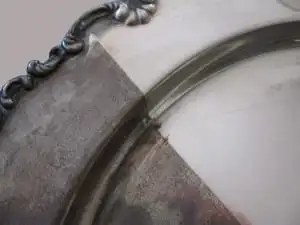Antique Silver needs Care: Silver Cleaning
ANTIQUE SILVER CLEANING
ART OBJECTS MADE OF SILVER AND THEIR CARE
Silver has always fascinated people. The special shine, the plasticity and its durability are the most important characteristics of this extraordinary material. In the following, we would like to provide some information about the unique shine of the antique silver art objects and why it is important to maintain it.
The brilliance of the silver makes up the charm of the objects. The shimmering grey was already attributed to cosmic origin in ancient times and was associated with the cool moon light. Furthermore, it was always a precious commodity and was used as a means of payment in addition to gold. Handcrafted silver objects and their polish fascinate us at sight and use. The unique reflections and light effects that are created in the metal are essential elements of enthusiasm for silver lovers. Therefore, it is necessary to preserve this lustre/shine of the material. However, silver has the characteristic of tarnishing. As a result, this lustre disappears and the aesthetic aspect of the silver art object can be affected.

Silver German Monteith Bowl, Gilt Inside, with Decorative Motifs of a Moon Goddess (object sold)
WHY DOES SILVER TARNISH?
Sulphide of hydrogen is gradually present in the air, and when it strikes silver, it reacts with the metal – formation of silver sulphide on the object. The silver turns black and is called tarnished silver. However, sulphur is not only found in the air, but also it is contained in some food. This is especially important when using table silver.
If silver objects are kept in the open air in a room and are not used, the hydrogen sulphide reacts with the silver and this slowly starts to tarnish. It does not turn black immediately, but after some time it becomes darker, and the brilliancy of the silver disappears.
Also acid, as is found in fruit or beverages, may cause tarnishing of silver. Salt even leads to corrosion and brown spots on the silver – a reason why salt cellars are usually gilded inside.
WHAT CAN BE DONE AGAINST TARNISHING?
In order to protect silver from the reaction with sulphur, there are several possibilities: The most unattractive method is to pack the objects air-tight and store them in a treasury. But that would be the end of the pleasure of a day-to-day observation. Storage in showcases or glass cabinets slows down the process of tarnishing. When the opening of the cabinet is not too frequent, the air does not circulate excessively and thus less hydrogen sulphide particles come into contact with the objects. Another possibility is the use. Regular use protects against discolouration. However, as noted above, attention must be paid to the properties of the food.
From the Property of the Wettin House
As a last option to make against the tarnishing is the regular cleaning. This has to occur of course also after use. The cleaning of the objects can be done following in several ways: warm water and a pH-neutral dishwashing detergent or silver polishing gloves are the most gentle methods. It is important to note that some commercial silver cleaning agents are abrasive. This means that the silver can be partially removed or scratched.
Furthermore, it should be noted that partly, for aesthetic purposes, tarnishing (patina) in some places is even desirable, so that it is counterproductive to remove it. Gilded objects or gilded areas are protected against tarnishing, but if this “protective cover” is no longer completely preserved, the underlying silver can tarnish. In such a case, be particularly careful not to use an abrasive silver cleaning agent for cleaning, since otherwise you could remove more of the gilding.
WHAT IS THE BENEFIT OF CLEANING?
The regular cleaning or use of silver objects preserves the unique brilliance of the material and therefore its very special charm. The longer the silver has been exposed to sulphur, the more persistent the sulphur sulphide formation are, which can render the cleaning very difficult.

The Silver Cleaning Lady
Residence Palace Heiducksburg, Rudolfstadt (Germany)
What’s more, the cleaning of silver objects is an almost meditative occupation and the close contact to one’s own objects strengthens the enthusiasm for the silver art object.
The shine, the polish and the reflection of the silver are the essential characteristics that always fascinate man. Moreover, the art objects are not just objects of pure enjoyment, they also represent a special values as well as a cultural property, which must be secured, whether in public or private hands. Hence, it is important to maintain the condition of the silver by regular care.

Antique Silver Platte
Left: tarnished – right: cleaned
The team of the Helga Matzke – European Silver is happy to help you with any arising questions on the care of antique silver or any other question on antique silver. Thus, do not hesitate to contact us.


